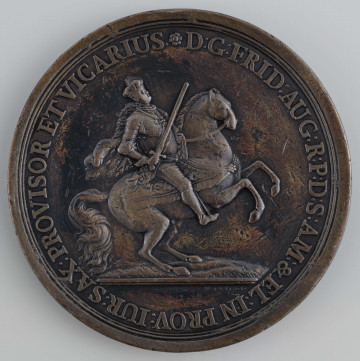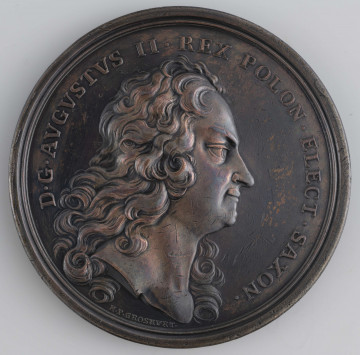
Augustus III is proclaimed Imperial vicar
1745
National Museum in Lublin
Part of the collection: Polish medallic art.
Although after the death of Augustus II the Strong (1733), by an overwhelming majority of votes the ‘Piast’ King, Stanisław Leszczyński was the elected king, in the end the throne of the Republic was won by his competitor, a foreigner, the son of the late monarch, the Elector of Saxony Frederick August II. He gained the crown thanks to the intervention of Russian troops, under cover of which his election was made, and Saxon troops, paving the way for the Elector to the Wawel Cathedral, where on 17 January 1734 he was crowned as August III (1733-1763).
The event was commemorated, among others, with a striking medal by Henryk Paweł Groskurt (c. 1675-1751), the best medallist of the time working at the Saxon court in Dresden. On one side it shows the bust of the king in the right profile, wearing a wig and decorative armour with an ermine cloak over it. The figure of the King is described by the inscription placed around it, which translates as: ‘By God's Grace August III, King of Poland, Grand Duke of Lithuania, Prince and Elector of Saxony’. At the bottom is the author's signature: H.P.GROSKVRT. On the reverse side there is a scene of the coronation. The crown is placed on the head of the kneeling elector by the Bishop of Cracow, Jan Aleksander Lipski, assisted by the Bishop of Poznań, Stanisław Józef Hozjusz, and the suffragan of Poznań, Adam Stanisław Grabowski. Among the secular dignitaries, attention is drawn to the figure of Duke Paweł Sanguszko with a Marshal's staff, and Jan Klemens Branicki with a sceptre on a tray. On the opposite side stand the Grand Crown swordsmen: Ignacy Zawisza and Duke Aleksander Jakub Lubomirski. The scene is completed by inscriptions in the arch and at the bottom, in translation: ‘By the unanimous vote of the free people’ and ‘Elected 5 October 1733, crowned 17 January 1734’ – of which the first part, as we know, did not correspond to reality.
This work deserves attention because of the realism of the coronation scene, free from classicist solutions and allegory prevailing in the medallic art of the time. At the same time, it is one of the few medals from that period in which the depicted people wear Polish clothes.
This medal was struck in gold, silver, bronze and tin, and later it was also cast in lead.
Our copy, produced in silver, was made in 1734.
Tomasz Markiewicz
Author / creator
Dimensions
cały obiekt: width: 55,5 mm
Object type
medal
Technique
stamp minting
Material
silver
Creation time / dating
Creation / finding place
Owner
The National Museum in Lublin
Identification number
Location / status

1745
National Museum in Lublin

1707
National Museum in Lublin

National Museum in Lublin
DISCOVER this TOPIC
Museum of King Jan III's Palace at Wilanów
DISCOVER this PATH
Educational path